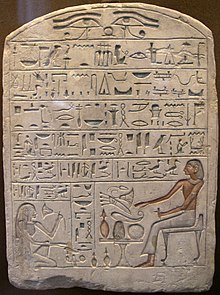 |
| Offering Formula |
To begin, the above Prayer List gives us a basic list of things that the deceased must have in their travels throughout the Underworld and afterlife. These prayer lists may have already existed however in spoken form until someone finally decided to write this down. This, soon after, led to the establishment of a Prayer for Offerings. This Prayer for Offerings would then become a substitute for the Prayer List which was already lengthy by that point in history. So if you, the reader, would like the author's opinion, it is possible that the first evidences of writing may have appeared in Egypt but that is debatable with the advent of writing found in Mesopotamia. It is imperative to understand as well that both the Prayer Lists and Prayer for Offerings, especially the Prayer Lists, existed during the Pre-dynastic period.
Getting back to Lichtheim though, it is equally noteworthy to understand that Ancient Egypt employed not only the Prayer Lists and Prayer for Offerings but in addition to these, they used autobiographies and catalogues of virtues. All of these literary devices can be found in the tombs of the Ancient Egyptians, which for our purposes here in the Old Kingdom, are called mastabas. Mastaba is the Arabic word for bench which is exactly what these tombs looked like. Now, it must be said that these autobiographies did not appear in Pre-dynastic tombs but rather in the tombs of the Old Kingdom prior to the Pyramid Age.
| Mastaba courtesy of wikipedia.com |
| Retainer Sacrifices courtesy of topnetz.com |
Moreover with the royal tomb itself, its goal was rather simple. The tomb was to allow the king to not only reside with his people but preside over the ceremonies for all eternity. Interestingly, the tomb of the kings was called Per Djet which does mean House of Eternity. Dominic Perry of the Ancient Egyptian History Podcast states that the kings of the Pre-dynastic period, with their tombs, prayer lists or offerings for prayers, and retainer sacrifices, had everything needed to enter the West or afterlife but not after traversing the Underworld which is another blog entirely of itself. Throughout the rest of the Pre-dynastic period and the Old Kingdom, it can be seen that, with each mastaba or tomb, that it becomes more and more elaborate. Prayer Lists led to Prayers for Offerings and then came autobiographies and catalogues of virtues. The tomb itself even become more elaborate with each king adding something else to the tomb which evolved into the colossi that is visible throughout the whole of Egypt today beginning with the king Netjerikhet and his Stepped Pyramid and leading to the pyramids that dominate the Giza plateau today.
In conclusion, the Pre-dynastic period and the Old Kingdom was a continuation of development in the wake of literature that can be seen in the forms of Prayer Lists, Prayers for Offerings and autobiographies on the tomb walls of the pharaohs. Unfortunately, this development led to the grim and shocking discovery of retainer sacrifices as well. Fortunately, this horrific practise came to an abrupt stop which would later be replaced by ushabti figurines that would serve their owners in the afterlife in later dynasties. Then finally the tomb, itself, served not only to house the king throughout all eternity but also allowed the king to preside over ceremonies. All of these things culminated in the rise of pharaoh not only as a king but as a divine king in later dynasties as well. It is through the development of literature and the tomb that kings began to elevate themselves to godhood as mentioned in the previous sentence and ensuring that they will enter the afterlife in safety.
References
Lichtheim, Miriam. 1973. Ancient Egyptian Literature Volume I: The Old and Middle Kingdoms
Wilkinson, Toby. January 2013. The Rise and Fall of Ancient Egypt
Perry, Dominic. Ancient Egyptian History Podcast. http://egyptianhistory.libsyn.com/
No comments:
Post a Comment